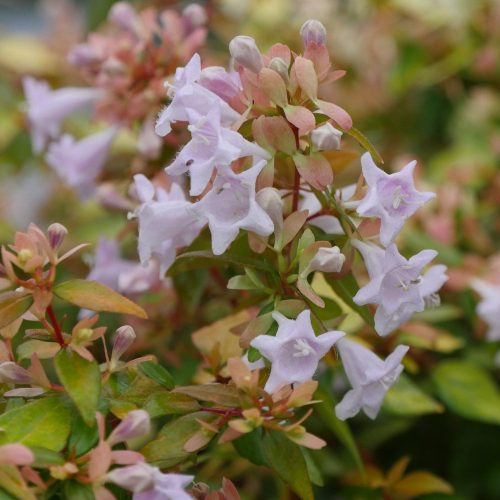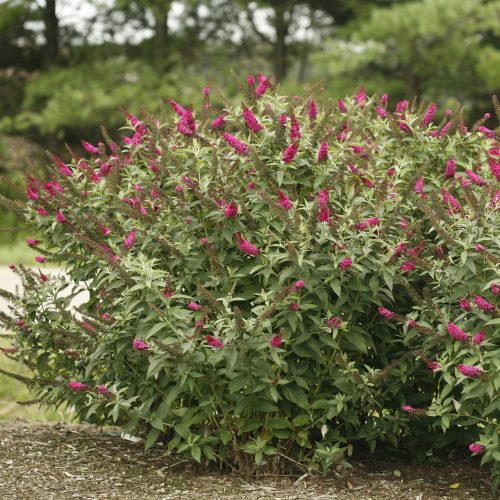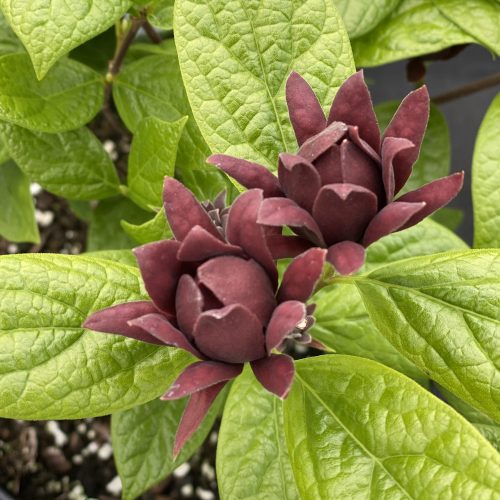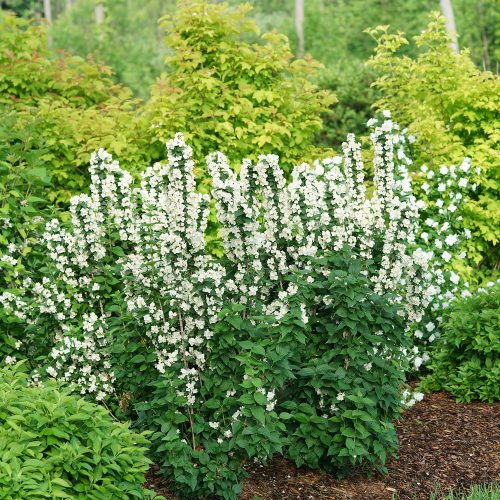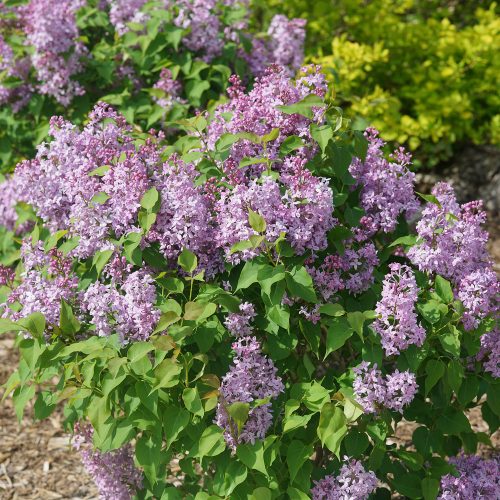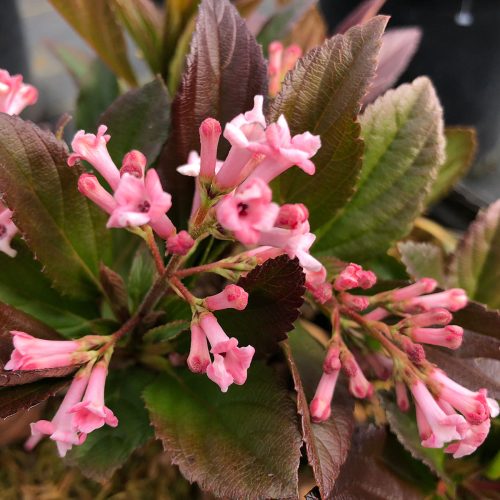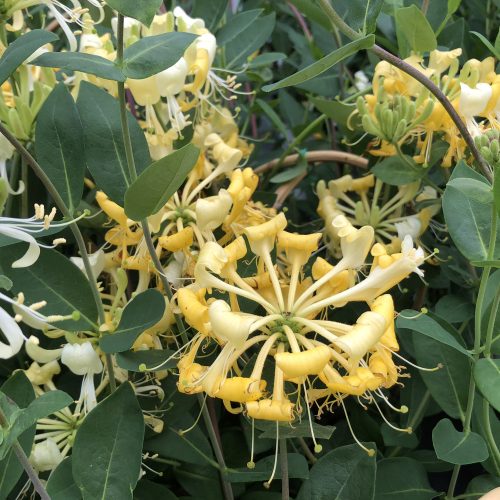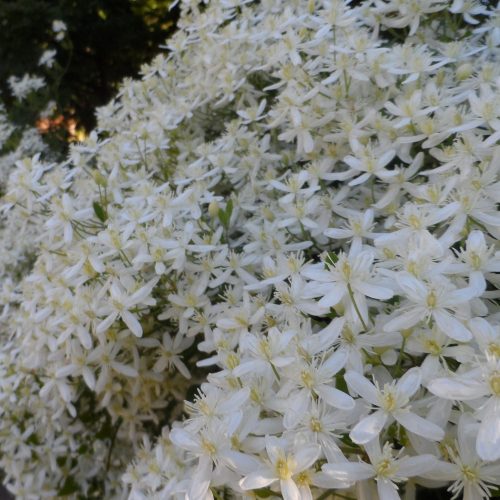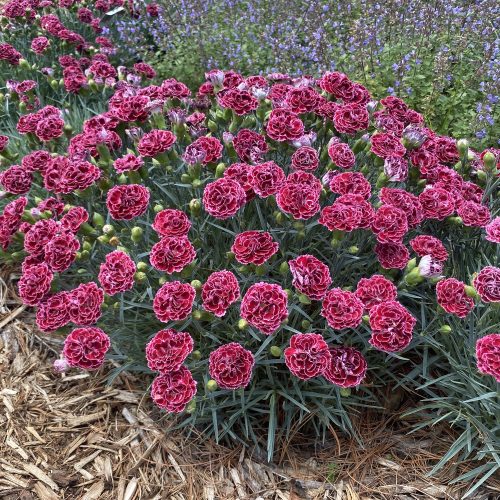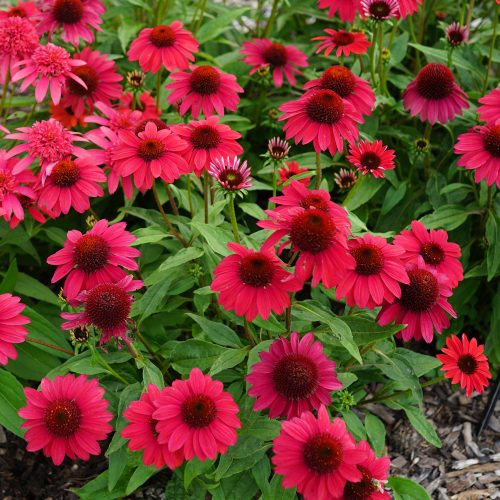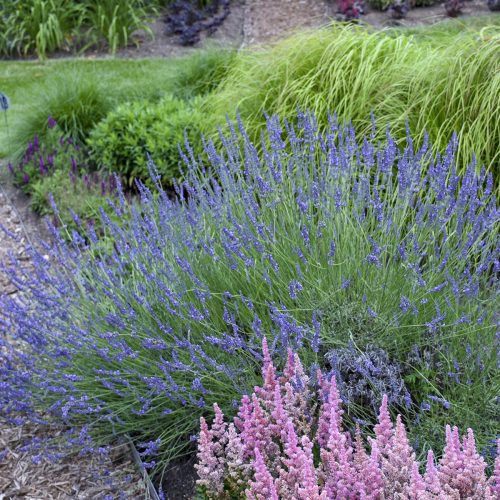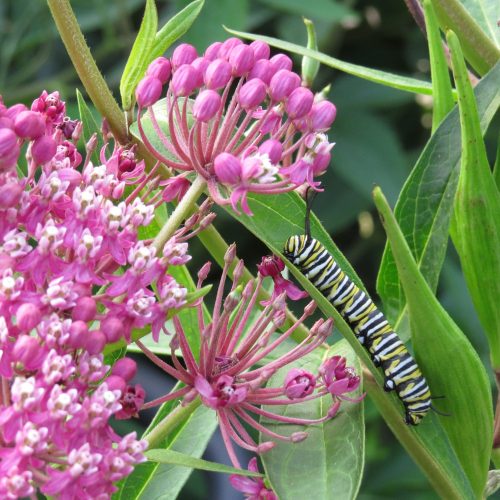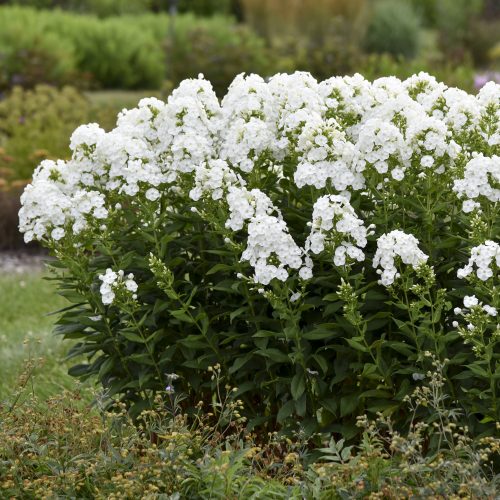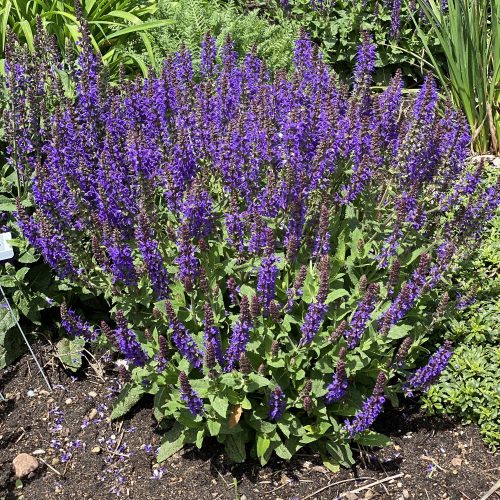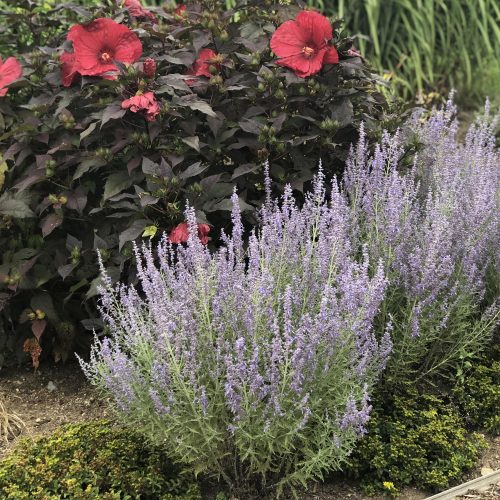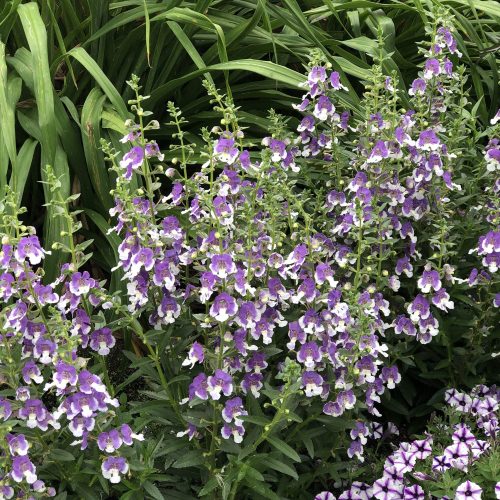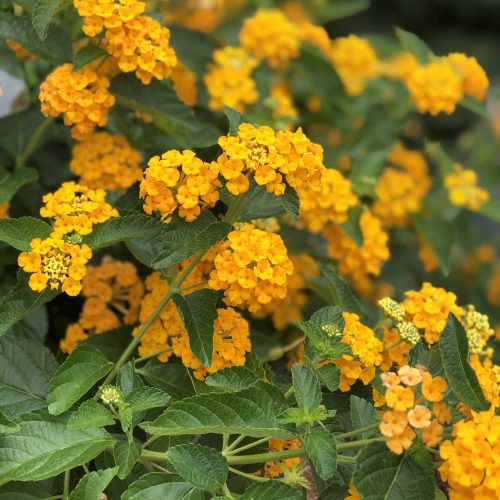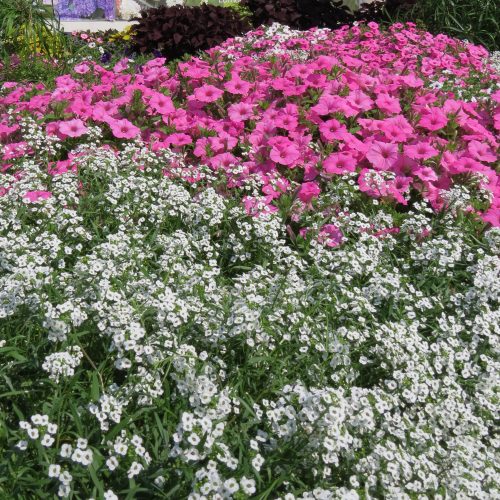When designing your garden, it’s important to consider elements like color, texture and shape, but don’t forget fragrance too. The sweet perfume of fragrant plants will enhance the way you experience your garden by engaging more of your senses, evoking memories tied to certain scents, and causing you to interact with your flowers more closely. Enjoy this list of 20 of our best fragrant flowering shrubs, perennials and annuals for your landscape and containers.
Abelia
You might grow abelia for its colorful foliage, but its sweet jasmine scented flowers in spring to summer are what will draw you over to this shrub again and again. Butterflies and hummingbirds take notice when it is in bloom, too. Look for varieties with gold, variegated or glossy foliage and flowers that range from pink to white. See all of our abelias.
Plant stats: Size ranges from 2-6’ tall by variety, winter hardiness ranges from zones 4-6 based on variety
Culture: Full sun to part shade, moist-well-drained soil, deer resistant, prune in early spring if needed
Butterfly Bush
Butterfly bushes (Buddleia) come in all shapes and sizes, from those that present their fragrant summertime blooms way up high to those that flower just below your knees. We like the taller ‘Miss’ series from Proven Winners® because they grow 4 to 5 feet tall and present their sweetly perfumed flowers right up at nose level. And since they are non-invasive, you won’t need to worry about pulling up unwanted seedlings. See all of our butterfly bush varieties.
Plant stats: Size ranges by variety from 18” tall to over 6’, hardy in zones 5-9
Culture: Full sun in all climates, average to dry, well-drained soil, deer resistant, prune back to healthy buds in spring
Sweetshrub
Another great fragrant plant – here’s an endearing shrub well-known to southerners, many of whom remember the fruity scent of their grandmother’s sweetshrub (Calycanthus). This easy to grow shrub blooms with exquisite deep burgundy flowers each year in early summer, and some varieties like ‘Aphrodite’ rebloom again later in the summer. Look for extra-fragrant varieties like Simply Scentsational® (pictured here) that were selected specifically for their extra-fragrant blossoms. See all of our sweetshrubs.
Plant stats: Size generally ranges from 6-10’ tall and wide, hardiness zone ranges from 4-5b depending on species
Culture: Full sun to part shade, average moisture, deer resistant, prune immediately after flowering if needed
Mockorange
Mockorange (Philadelphus) has been around for ages, but it fell out of fashion for quite some time because the plant’s habit left much to be desired after it was finished flowering. All of that has changed with newer varieties like the Illuminati® series. These are beautiful shrubs with attractive foliage and elegant form from spring through fall. Of course, they are still grown primarily for their out-of-this-world fragrant, white flowers in the springtime. A great fragrant plant, they make great cut flowers, too. See all of our mockorange varieties.
Plant stats: Generally about 3-4’ tall, hardy in zones 4-7
Culture: Full sun to part shade, average to dry soil, deer resistant, prune immediately after flowering if needed
Roses
If you’re looking for a rose that smells like a rose “should” smell like but don’t want to deal with the hassle of spraying for disease, look to modern hybrids like the new Reminiscent™ series or At Last® landscape rose. They combine the signature perfume of the most beloved roses with healthy, shiny green foliage that fends off black spot and powdery mildew. Their strong ability to rebloom will keep your vases full of fresh flowers all summer. See all of our roses.
Plant stats: Generally about 2-4’ tall, winter hardiness ranges from zones 3-5 based on variety.
Culture: Full sun, average to moist, well-drained soil, prune back to healthy buds in spring
Lilac
This is perhaps the most obvious plant on our list, but we couldn’t write a list of fragrant garden plants without including lilacs (Syringa)! Is there any better scent to usher in the spring? While some cultivars grow very large and need lots of space to grow, there are several excellent dwarfs now available like Baby Kim®. Also look for reblooming Bloomerang® varieties that deliver those deliciously scented blossoms in spring and again from late summer to fall. See all of our lilacs.
Plant stats: Size ranges greatly from 18” to 10’ tall, hardiness ranges from zones 2 or 3 up through zones 7 or 8 depending on cultivar
Culture: Full sun, average well-drained soil, deer resistant, prune immediately after flowering if needed
Fragrant Viburnum
There are many species of viburnum to choose from, many of which are native to the U.S. They make durable, easy care shrubs for foundation plantings, screening, and adding structure to the landscape. Though not all have fragrant flowers, those that do are very notably fragrant with a scent similar to jasmine. They fill the garden with their sweet perfume in the springtime, drawing in pollinators in the process. A few of our favorite fragrant varieties include Sweet Talker® (pictured here), Spice Baby® and Spice Girl®.
Plant stats: Size ranges greatly by variety, typically 4-10’ tall, winter hardiness ranges by species
Culture: Full sun to part shade, average well-drained soil, deer resistant, prune immediately after flowering if needed
FRAGRANT FLOWERING VINES
Honeysuckle
The sweetly scented flowers and fast growth rate of honeysuckle vine (Lonicera) makes it ideal for growing up arbors and pergolas where you’ll notice its honeylike perfume each time you pass under. We are especially fond of ‘Scentsation’, a long blooming, non-invasive cultivar that produces large, yellow flowers from mid-spring to late summer followed by bright red berries.
Plant stats: 10’ tall, hardy in zones 4-9
Culture: Full sun to light shade, adapts to most soil types, deer resistant, prune after flowering if needed or prune out vines that have grown out of bounds anytime during the growing season
Sweet Autumn Clematis
A rare exception for clematis, this species Clematis terniflora, commonly known as sweet autumn clematis, bears softly fragrant blossoms which begin their show in late summer and continue into early fall. Each white flower is about the size of a quarter, but they are produced by the thousands on mature plants and followed by attractive seed heads. This species is also unusual in its shade tolerance, blooming well even with as little as four hours of sun. It is a vigorous vine and establishes quickly in the landscape. Be sure to provide an extra-large trellis, fence or arbor for it to climb.
Plant stats: 10-20’ tall, hardy in zones 4-9
Culture: Full sun to part shade, average to moist soil, deer resistant, cut back in late fall to prevent reseeding and limit growth if needed
FRAGRANT FLOWERING PERENNIALS
Dianthus
Unless you’ve spent some time on your hands and knees in your garden, you might not have noticed that your dianthus were fragrant. Indeed, they are! Their scent ranges from sugar sweet to clove-like, depending on the species. Fragrance might not be as important to you in the low, wide spreading cultivars of dianthus like the ‘Paint the Town’ series. But you’ll definitely appreciate the fragrance of the Fruit Punch® varieties since their sweetly scented, mini carnation-like flowers make pretty, long-lasting posies. See all of our Dianthus.
Plant stats: Generally 6-10” tall in bloom, hardy in zones 4-9
Culture: Full sun to part shade, average to dry, well-drained soil, deer resistant, shear back the flowers after they are all spent to encourage rebloom in the fall
Echinacea
There is so much to love about coneflowers, from their cheerful blooms in so many different colors to their long-blooming nature and attractiveness to pollinators and songbirds. When you clip a few for your summertime bouquets, you’ll also notice their sweet honey-like fragrance that emanates from the spiky cone. Most coneflower varieties are fragrant so all that’s left is to choose your favorite color, or better yet, collect one of each! See all of our Echinacea.
Plant stats: Generally 1-3’ tall, hardiness ranges from zones 3 or 4 to 8 or 9 depending on variety
Culture: Full sun to part shade (best in more sun), average to dry, well-drained soil, deer resistant, deadhead as needed, cut back in early spring
Lavender
A must-have for every sunny garden, lavender has been widely grown for its classic fragrance for centuries. Its sweet buds and the oils extracted from the plant are often used to add fragrance to soaps, lotions, perfumes, essential oils, baked goods, drinks and more. Look for varieties with extra-long stems like Phenomenal® (pictured here) to use for cutting or more dwarf selections that make beautiful short hedges. See all of our lavender varieties.
Plant stats: Generally 12-30” tall depending on variety, hardiness ranges from 4 to 5 depending on species
Culture: Full sun and well-drained soil are a must, dry to average moisture, deer resistant, prune back to healthy buds in spring
Swamp Milkweed
Your first reason for planting swamp milkweed (Asclepias incarnata) may be because it is highly beneficial to monarch butterflies as a host plant. But there are many additional reasons why this beautiful native perennial is worthy of planting in your garden. You’ll enjoy its vanilla-scented, cotton candy pink or white flowers for several months beginning in midsummer. Instead of cutting them to enjoy indoors, leave them be so they can provide nectar for the many pollinators that enjoy them. Swamp milkweed is an excellent species for planting in clay soils since it thrives in moist to wet soil. See all of our Asclepias.
Plant stats: 3-5’ tall, hardy in zones 3-9
Culture: Full sun, average to wet soil, deer resistant, cut back to the ground in the spring
Tall Garden Phlox
This classic perennial for sunny to partly sunny landscapes exudes a sweet fragrance from its large flower clusters each year beginning in midsummer, often lasting until fall. Butterflies and pollinating bees are frequent visitors, as well as the occasional hummingbird. Look for shorter knee-high cultivars for the front of the border and those that grow nearly 4’ tall, blooming in shades of pink, purple, coral or white. See all of our tall garden phlox.
Plant stats: Height ranges greatly by variety from 1.5’ to nearly 4’, hardy in zones 4-8
Culture: Full sun to part shade, average well-drained soil, cut back to the ground in late fall
Perennial Salvia
You know the scent of herbal sage used in cooking? Ornamental perennial salvia (sage) is grown for its flowers but has a similar aroma that you’ll notice if you pick a few stems for a bouquet or crush its foliage. This scent makes it highly unattractive to deer and rabbits, but pollinators adore it. Combined with decent drought tolerance and an ability to thrive in intense sun, this low maintenance perennial performs beautifully year after year. Shearing back the flowers once they are spent in midsummer often encourages a fresh flush of blooms. See all of our perennial salvias.
Plant stats: Generally 14-20” tall depending on variety, hardy in zones 3-8
Culture: Full sun, dry to average, well-drained soil, deer resistant, prune spent flower stalks down after blooming to encourage rebloom
Russian Sage
Like perennial salvia, Russian sage (Perovskia) has a strong herbal scent that you’ll easily detect if you cut its stems or crush its foliage. It grows in the same conditions, too, thriving in dry heat. Two of the main ways they differ are in their bloom time and foliage type. Russian sage blooms much later in the season, beginning in mid to late summer and continuing into fall. Its small, toothed, silvery green leaves line the woody stems, appearing much like a small shrub in the landscape. See all of our Russian sage.
Plant stats: Ranges from 2-4’ tall depending on cultivar, hardy in zones 4-9
Culture: Full sun, dry to average, well-drained soil, deer resistant, prune back to healthy buds in spring
Angelonia
Not many annual flowers are notably fragrant, but one you might not have tried yet is Angelonia, commonly called summer snapdragon. Some describe its fruity fragrance like grape soda. It’s enough to keep deer at bay but butterflies coming back for an occasional snack. Strong heat tolerance makes this an annual that grows well everywhere from Michigan to Florida. Look for varieties that bloom in shades of pink, purple, blue and white on plants with habits that range from low and cascading to tall and upright. See all of our Angelonia.
Plant stats: Size ranges by variety from 8-36”, grown as an annual
Culture: Full sun, drier to moist soils that are well-drained, deer resistant, deadheading not needed for rebloom but will help plants bulk up
Lantana
Lantana smells as good as it looks! Abundant blossoms in fruity shades of gold, red, pink, purple and white are sweetly fragrant, attracting butterflies and hummingbirds all summer long. Look for varieties like Luscious® lantana that set little to no seed, which keeps them in bloom all season without needing to be deadheaded. Note the plant’s size before you buy since lantanas can range greatly in size and habit. See all of our lantanas.
Plant stats: 12-30” tall depending on variety, grown as an annual
Culture: Full sun, dry to average soil that is well-drained, deer resistant, deadheading not needed for non-stop blooms
Sweet Alyssum
Bearing a beautiful, nostalgic scent like none other, sweet alyssum is a perfect plant for lining the edges of pathways, bordering patios and spilling down the sides of large containers. Today’s varieties are not your grandmother’s sweet alyssum that stopped blooming and went to seed as soon as the summer heat settled in. The Proven Winners varieties we offer are vigorous, sterile and heat tolerant, blooming non-stop from spring until frost without deadheading. See all of our sweet alyssum.
Plant stats: 8-16” tall depending on variety, grown as an annual
Culture: Full sun to part shade, average to moist soil—this plant does not like to dry out, deadheading not needed for non-stop blooms

